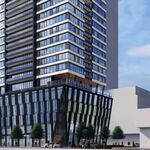Time to Trash Transit City
February 20, 2010
By MIKE STROBEL
Read More: http://www.torontosun.com/news/columnists/mike_strobel/2010/02/20/12963476.html
#######################################################################
Let’s sink Transit City. Tram City. Wham-Bam-Tram City.
Before it sinks us like Atlantis. Why? Well, the answer lies in the warm bosom of Mother Earth downtown — beneath the spires of Bay St., beneath the hotels, the convention halls, the traffic.
It’s PATH, a useful and commonsense thing City Hall has done for us. And thus very rare. PATH is the largest underground retail complex in the world — 27 km of tunnels housing 1,200 shops.
It never rains or snows. The walkways never ice up. There are no traffic jams. No stalled vehicles. No red lights to run. No frozen rail signals. No cussing drivers. The worst collisions are between fat guys walking.
There’s a plan afoot to double PATH, it’s so successful. It has done what planners hoped: Unclog downtown sidewalks and keep pedestrians snug and safe. That’s because it’s separate and underground — a boon in The Great White North, even in as mild a winter as this one.
What else is underground? Bing, bang, bong. Exactly. A subway.
What is mostly not underground? What will worsen the madcap world of snow, sleet, year-round bicycle lanes and drivers just in from the tropics?
You got it. Transit City. Mayor David Miller’s Transitopia.
Want a glimpse of Miller’s and Howard Moscoe’s and Adam Giambrone’s vision?
Spend the day hauling your sorry ass along St. Clair W. By car, bike or on foot. Even by streetcar. Lots of empty seats. Only a rabid Transitopian would still embrace Transit City.
Or hop on the Orient Express, as I like to call it, along Spadina. That streetcar right-of-way has done diddly-squat to speed travel through Chinatown, while hurting parking and aesthetics.
Now, imagine St. Clairs and Spadinas all over the place and voila: The $8.3-billion (and not a penny more, right?) Transit City. Streetcars masquerading as LRT will cruise such far-flung main drags as Finch, Sheppard, Jane, Don Mills and Lake Shore Blvd. — gumming up traffic as they go.
#######################################################################




